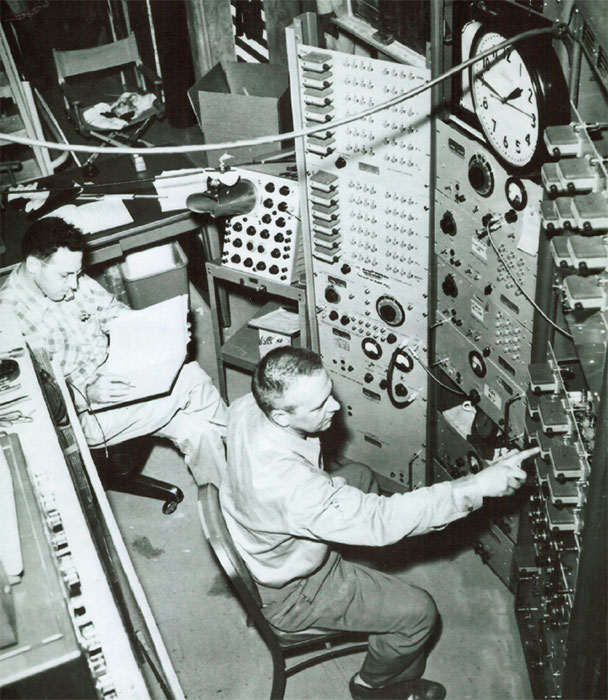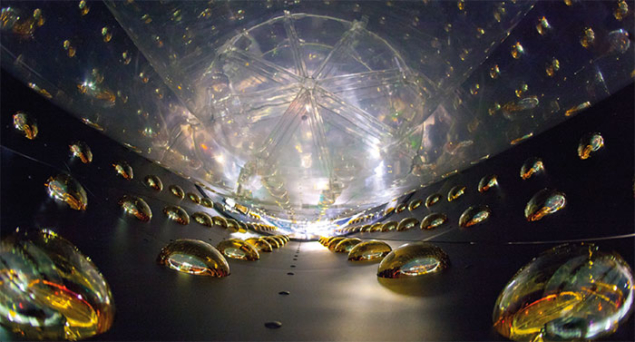The 1956 experiment that proved neutrinos exist.

In July 1956, in a brief paper published in Science, a small team based at the Los Alamos National Laboratory in the US presented results from an experiment at a new, powerful fission reactor at the Savannah River Plant, in South Carolina. The work, they wrote, “verifies the neutrino hypothesis suggested by Pauli”. Clyde Cowan, Fred Reines, Kiko Harrison, Herald Kruse and Austin McGuire had demonstrated for the first time that it was possible to detect neutrinos, setting in motion the new field of neutrino physics. The key ingredients were an intense source and a big detector, with more than a touch of ingenuity and patience.
More than two decades previously, in 1930, Wolfgang Pauli had proposed that the “energy crisis” in nuclear beta decay – presented by the continuous energy spectrum of the emitted electron – would be solved if the decaying nucleus also emitted a second, undetected particle. This would allow the energy released to be shared between three objects, including the recoiling nucleus, and so yield electrons with a range of energies, just as observed. The new particle had to be neutral and have a relatively small mass. Pauli called his proposal “a desperate remedy”, in part because he thought that if such a particle did indeed exist, then it “would probably have long ago been seen”.
Nevertheless, Enrico Fermi took the possibility seriously and based his seminal work on beta decay, published in 1934, on a point-contact interaction in which a neutron decays to a proton, electron and (anti)neutrino: n → p e– ν. Soon afterwards, Hans Bethe and Rudolf Peierls calculated the cross-section for the inverse reaction in which a neutrino is absorbed, but when they found a value of about 10–44 cm2, the pair concluded that no one would be able to detect neutrinos (Bethe and Peierls 1934). What they did not count on was the discovery of nuclear fission – which on a macroscopic scale produces copious numbers of neutrinos – or the ingenuity of experimentalists and, later, accelerator physicists.
Notoriously, nuclear fission was first applied in the atomic bombs used towards the end of the Second World War. A few years later, in 1951, Fred Reines, a physicist who had worked on the Manhattan Project at Los Alamos, began to think about how to harness the neutrinos produced during tests of atomic bombs to make a direct detection of the elusive particle. He was soon joined in this strange pursuit by Clyde Cowan, a fellow researcher at Los Alamos, after they were stranded together at Kansas Airport, where the conversation turned to the “supreme challenge” of detecting neutrinos.
Reines had an idea to place a detector close to a bomb-test tower and use the timing of the detonation as a “gate” to minimise background. But what kind of detector? He and Cowan decided on the recently developed medium of liquid scintillator, which could both act as a target for the inverse beta-decay reaction ν p → e+ n, and detect the emitted positrons via their annihilation to gamma rays. It was an audacious plan, not only in taking advantage of a bomb test but also in scaling up the use of liquid scintillator, which until then had been used only in quantities of about a litre. Reines and Cowan named it “Project Poltergeist”, to reflect the neutrino’s ghostly nature.

Remarkably, the Los Alamos director gave approval for the experiment. However, in late 1952, Cowan and Reines were urged to reconsider the more practical idea of using antineutrinos from a nuclear reactor. The challenge was to work out how to reduce the backgrounds, because the antineutrino flux from a reactor would be thousands of times smaller than that from a nuclear explosion. Reines and Cowan realised that in addition to looking for positron annihilation, they could also detect the neutrons through neutron capture – a process that is delayed for several microseconds, thanks to the neutron’s random walk through a medium prior to interacting with a nucleus. In particular, the addition of cadmium to the detector would increase the likelihood of capture and lead to the emission of gamma rays. The signature for inverse beta decay would then be a delayed coincidence between two sets of gamma rays: one from the positron’s annihilation and the other from the neutron’s capture.
The detector for Project Poltergeist contained 300 litres of liquid scintillator with added cadmium chloride, viewed by 90 photomultiplier tubes, and was set up in 1953 at a new reactor at the Hanford Engineering Works in Washington State. This initial experiment showed a small increase in delayed coincidences when the reactor was operating compared with the situation when it was turned off, but it was set against a cosmic-ray background that was more than 10 times higher than the expected signal rate (Reines and Cowan 1953).
This tantalising result encouraged a still more determined effort, with a new detector design that was basically a sandwich with three layers of liquid scintillator and two layers of water with added cadmium chloride to act as the target (figure 1). Positrons produced in a neutrino interaction would be detected almost immediately via two back-to-back gamma rays in the adjacent scintillator tanks, which would be followed a few microseconds later by another burst of gamma rays in the same two scintillator tanks, this time from neutron capture.
The second experiment ran at the newly completed Savannah River Plant for a total of 1371 hours in 1956 and, when the reactor was on, it recorded nearly three delayed coincidences per hour (Cowan et al. 1956). After completing many checks, on 14 June 1956 Reines and Cowan sent a jubilant telegram to Pauli in Zurich, informing him that they had “definitely detected neutrinos from fission fragments by observing inverse beta decay of protons”. At the time, Pauli was in fact at a meeting at CERN, to where the telegram was forwarded, and he reportedly interrupted the meeting to read out the good news, later celebrating with a case of champagne (Reines 1979).
The move to accelerators
At the time of the neutrino’s discovery, laboratories such as CERN and Brookhaven were on their way to building proton synchrotrons that would have sufficient energy and intensity to form beams of neutrinos via decays of pions and kaons produced when protons strike a suitable target. The muons produced in the decays could be stopped by large amounts of shielding, allowing only neutrinos to penetrate to experiments beyond. At Brookhaven, this led to the discovery at the Alternating Gradient Synchrotron (AGS) in 1962 that the neutrinos produced in association with electrons (as in beta decay) are different from those produced in association with muons (as in pion decay): a second type of neutrino, the muon neutrino, had been discovered.

In 1963, an ingenious way to produce neutrino beams of greater intensity first came into use at the Proton Synchrotron (PS) at CERN, where Simon van der Meer had described his concept of the neutrino horn a couple of years earlier (van der Meer 1961). Because neutrinos are electrically neutral, they cannot be focused into a beam using magnets, so he devised instead a way to focus the parent pions and kaons using magnetic fields set up by currents circulating in a metallic cone-shaped “horn” (CERN Courier June 2011 p24). The device concentrated neutrinos produced as the charged particles decayed in flight into a beam, and because it could focus either positive or negative particles, it produced an almost pure beam of neutrinos (from positive parents) or antineutrinos (negative parents). A second technical innovation at CERN enabled the horn to become a formidable device: the technique of “fast ejection”, devised by Berend Kuiper and Günther Plass, could direct all of the protons from one cycle of the PS onto the target at the mouth of the horn (Kuiper and Plass 1959). By mid-1963, thanks to these innovations, CERN had what was at the time the world’s most intense neutrino beam.
In the 1970s, the combination of the neutrino beam from the PS and Gargamelle – the large bubble chamber built at the Saclay Laboratory by a team led by André Lagarrigue – led to the discovery of weak neutral currents (CERN Courier September 2009 p25), thereby providing crucial experimental support for the unification of the weak and electromagnetic forces. The neutrino experiments with Gargamelle also produced key evidence about the existence of quarks and, in particular, their fractional charges (CERN Courier April 2014 p24). Then, in 1977, the Super Proton Synchrotron (SPS) became the source of neutrino beams at higher energies, and for the next 21 years a series of experiments in CERN’s West Area used neutrinos in experiments covering a broad range of physics, from neutral currents and the quark structure of matter through quantum chromodynamics to neutrino oscillations (CERN Courier December 1998 p28).
Around that time, physicists at Fermilab were closing in on a third neutrino type. The DONUT experiment (Direct Observation of the NU Tau) detected neutrinos produced at the Tevatron, and in 2000, the collaboration announced the discovery of the tau neutrino. Although experiments at CERN’s Large Electron–Positron collider had already established from precise measurements of the Z boson that there are three light neutrino types, the observation of the tau neutrino completed the leptonic sector of the Standard Model.
Ten years later, CERN was again setting records for neutrino beams, with the CERN Neutrinos to Gran Sasso (CNGS) project, which directed an intense beam of muon-neutrinos (νμ) to two experiments, ICARUS and OPERA, in the Gran Sasso National Laboratory in Italy about 730 km away. CNGS followed the same principle as CERN’s early record-breaking beam, this time with protons from the SPS. Following first commissioning in 2006 (CERN Courier November 2006 p20), the facility ran for physics from 2008 to the end of 2012, and achieved a maximum beam power of 480 kW – the most powerful at the time. A total of 18.24 × 1019 protons were delivered on target, and the OPERA experiment detected 19,500 neutrino events – with five among them identified as a tau neutrino (ντ), thereby firmly establishing the direct observation of νμ→ ντ oscillations (CERN Courier July/August 2015 p6).
A bountiful legacy
Since the first glimpses of antineutrino interactions 60 years ago in reactor experiments, experiments have gone on to detect neutrinos and antineutrinos produced in a variety of ways – both in beams created at particle accelerators and also naturally by reactions in the Sun, interactions of cosmic rays in the Earth’s atmosphere and, most recently, astrophysical processes. We now know that neutrinos exist not only in three flavour eigenstates – electron (νe), muon (νμ) and tau (ντ) – but also in different mass eigenstates (ν1, ν2 and ν3) with very small masses, and that they can oscillate from one flavour to another through quantum-mechanical mixing (see “Japan eyes up its future”).
Reactor experiments – in particular Double Chooz in France, the Daya Bay Reactor Neutrino Experiment in China (figure 2) and the Reactor Experiment for Neutrino Oscillation (RENO) in South Korea – are still as relevant now as they were in Cowan and Reines’ day. Modern nuclear power plants produce about 1020 electron antineutrinos (νe) per second and experiments based on the same liquid-scintillator concept continue to provide essential contributions to neutrino physics by looking for the “disappearance” of the νe.
Sixty years after the first detection of the neutrino, and more than 80 years after the particle was tentatively predicted, experiments with neutrinos continue to have a leading role in particle physics. Today, experimentalists around the world are vying to determine precisely the mixing parameters of the neutrino, including the masses. The measurements may prove to hold the answers to some key questions in the field – ensuring that the “supreme challenge” of creating and detecting neutrinos will remain a worthwhile and exciting pursuit for the foreseeable future.





